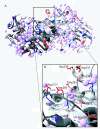Function and biotechnology of extremophilic enzymes in low water activity
- PMID: 22480329
- PMCID: PMC3310334
- DOI: 10.1186/2046-9063-8-4
Function and biotechnology of extremophilic enzymes in low water activity
Abstract
Enzymes from extremophilic microorganisms usually catalyze chemical reactions in non-standard conditions. Such conditions promote aggregation, precipitation, and denaturation, reducing the activity of most non-extremophilic enzymes, frequently due to the absence of sufficient hydration. Some extremophilic enzymes maintain a tight hydration shell and remain active in solution even when liquid water is limiting, e.g. in the presence of high ionic concentrations, or at cold temperature when water is close to the freezing point. Extremophilic enzymes are able to compete for hydration via alterations especially to their surface through greater surface charges and increased molecular motion. These properties have enabled some extremophilic enzymes to function in the presence of non-aqueous organic solvents, with potential for design of useful catalysts. In this review, we summarize the current state of knowledge of extremophilic enzymes functioning in high salinity and cold temperatures, focusing on their strategy for function at low water activity. We discuss how the understanding of extremophilic enzyme function is leading to the design of a new generation of enzyme catalysts and their applications to biotechnology.
Figures



Similar articles
-
Extremophilic Oxidoreductases for the Industry: Five Successful Examples With Promising Projections.Front Bioeng Biotechnol. 2021 Aug 12;9:710035. doi: 10.3389/fbioe.2021.710035. eCollection 2021. Front Bioeng Biotechnol. 2021. PMID: 34458243 Free PMC article. Review.
-
Solvent tolerant enzymes in extremophiles: Adaptations and applications.Int J Biol Macromol. 2023 May 31;238:124051. doi: 10.1016/j.ijbiomac.2023.124051. Epub 2023 Mar 16. Int J Biol Macromol. 2023. PMID: 36933597 Review.
-
Industrial relevance of thermophilic Archaea.Curr Opin Microbiol. 2005 Dec;8(6):649-55. doi: 10.1016/j.mib.2005.10.015. Epub 2005 Oct 27. Curr Opin Microbiol. 2005. PMID: 16257257 Review.
-
Nature versus nurture: developing enzymes that function under extreme conditions.Annu Rev Chem Biomol Eng. 2012;3:77-102. doi: 10.1146/annurev-chembioeng-061010-114239. Epub 2012 Feb 23. Annu Rev Chem Biomol Eng. 2012. PMID: 22468597 Review.
-
Properties and Applications of Extremozymes from Deep-Sea Extremophilic Microorganisms: A Mini Review.Mar Drugs. 2019 Nov 21;17(12):656. doi: 10.3390/md17120656. Mar Drugs. 2019. PMID: 31766541 Free PMC article. Review.
Cited by
-
Proteins maintain hydration at high [KCl] concentration regardless of content in acidic amino acids.Biophys J. 2021 Jul 6;120(13):2746-2762. doi: 10.1016/j.bpj.2021.05.015. Epub 2021 Jun 2. Biophys J. 2021. PMID: 34087206 Free PMC article.
-
Understanding High-Salt and Cold Adaptation of a Polyextremophilic Enzyme.Microorganisms. 2020 Oct 16;8(10):1594. doi: 10.3390/microorganisms8101594. Microorganisms. 2020. PMID: 33081237 Free PMC article.
-
Characterization of the Proteolytic Activity of a Halophilic Aspergillus reticulatus Strain SK1-1 Isolated from a Solar Saltern.Microorganisms. 2021 Dec 24;10(1):29. doi: 10.3390/microorganisms10010029. Microorganisms. 2021. PMID: 35056479 Free PMC article.
-
Protein adaptations in archaeal extremophiles.Archaea. 2013;2013:373275. doi: 10.1155/2013/373275. Epub 2013 Sep 16. Archaea. 2013. PMID: 24151449 Free PMC article. Review.
-
Circular dichroism and fluorescence spectroscopy of cysteinyl-tRNA synthetase from Halobacterium salinarum ssp. NRC-1 demonstrates that group I cations are particularly effective in providing structure and stability to this halophilic protein.PLoS One. 2014 Mar 3;9(3):e89452. doi: 10.1371/journal.pone.0089452. eCollection 2014. PLoS One. 2014. PMID: 24594651 Free PMC article.
References
-
- Hough DW, Danson MJ. Extremozymes. Curr Opin Chem Biol. 1999;1:39–46. - PubMed
-
- Gomes J, Steiner W. The biocatalytic potential of extremophiles and extremozymes. Food Technol Biotechnol. 2004;42:223–235.
-
- Iyer PV, Ananthanarasyan L. Enzyme stability and stabilization-aqueous and non-aqueous environment. Process Biochem. 2008;43:1019–1032.
LinkOut - more resources
Full Text Sources

